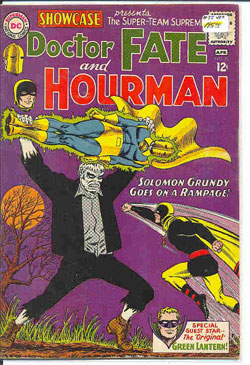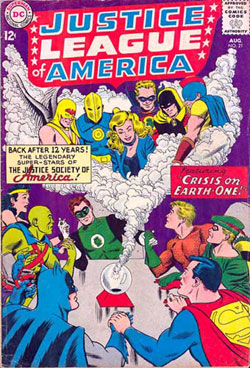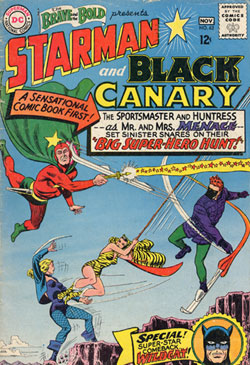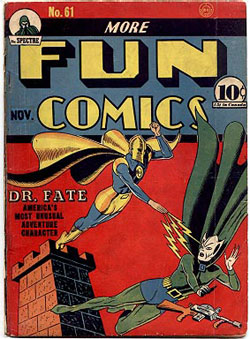|
|
 |
If you were born in the years just after World War II, your life's biggest regret is that you missed out on the splendors of the Golden Age. The sad realization that it was already long gone by the time you would have been old enough to have even been aware of that wonderful era would forever leave you with an unfulfilled thwarted feeling.
So the chances of knowing anything about Doctor Fate were few and far between until the issue which is the subject of this article made its appearance in the mid-sixties. Indeed there was a total of only three separate occasions previous to the 1965 publication of this issue when the postwar generation could have ever suspected that a superhero like Doctor Fate had previously existed. And those revelations would tantalize and whip up the state of expectancy and anticipation that greeted the appearance on the newsstands of Showcase #55 in early 1965 (at last!). Just as he had made is Golden Age debut in the 55th issue of More Fun, was it 'fate' that he would appear in the 55th issue of Showcase?
Babyboomers' initial glimpse of Doctor Fate had been back in late 1961 in Showcase #34--known more famously for the debut of the Silver Age Atom. This issue included a reproduction of the charter members of the Justice Society taken from the cover of All-Star #3 and it's there that you would have had your introduction to the Mystical Mage. What an impression this single image would make! Who CARES about the Atom? I don't wish to make light of the deprivations of those who lived though the Great Depression of the 1930's, but at least they could look forward to the Golden Age debut of Doctor Fate in 1940.
Someone once told me that what makes Doctor Fate's initial visual impact so unforgettable on readers in his helmet which appears to have no other function than to cover his entire face and leave as little room as possible for any kind of facial expression to be seen (the original Sandman's face was also completely covered, but with something a whole lot less glamorous--a gasmask). When Gardner Fox was once interviewed about the 1940 creation of Doctor Fate, he made a point of emphasizing that although the rest of the costume was the artist's conception, it was Fox who had suggested the helmet which is modeled after headgear worn by ancient Greek warriors. And concerning the impact of Doctor Fate's appearance, panels from later issues of his More Fun stories and his All-Star chapters included some of the exact same poses that appeared in earlier issues of both titles indicating that the original images were probably traced and then inserted in later stories.
Digressing momentarily on the subject of theater and history, it may be informative to know that masked drama is found throughout the world and though its popularity has declined (since it, too, has had to compete with television, the Internet--and comic books), it once was an important form of entertainment in many cultures. And although it may seem contradictory for actors to be prevented from showing their facial expressions to audiences while delivering their lines by wearing masks which cover part or even all of their faces, if you have ever actually seen masked drama (I have seen Japanese Noh plays), there are moments of dramatic intensity that are not only powerful, eerie, and unforgettable, but downright electrifying. Getting back to those ancient Greek warriors, they must have realized that an enemy facing an entire army of soldiers wearing headgear like Doctor Fate's would probably receive a psychological impression akin to not only lacking a clue as to what was on their adversaries' minds, but also of not being in control of the situation and not knowing what was coming next. Just as people feel compelled to fill a vacuum or a void, a blank expression evokes a reaction from viewers which often reflects their own sublimated fears and subconscious insecurities. One reason why I rate Showcase #55 so far above #56 is because, in a few panels of the latter issue, a crude facial expression is scrawled (and I DO mean SCRAWLED!) on FATE's helmet (highly illogical, as Mr. Spock would say) totally ruining the effect of the helmet's blank stare not to mention being just plain ugly. (I have often wondered if, after Anderson submitted his work, someone else went over it and proceeded to make 'improvements'.)
Could this have been a sign of the times where the shift to angst-ridden personalities would begin to dominate the superhero scene? Instead of serving as a medium from which to momentarily escape reality, was the role of the comic book changing to provide readers with a reflection of reality by including psychological overtones as a means of allowing the reader to identify more closely with the psyche of the superhero? Was this just another tremor in the comic book industry that would eventually lead to the inevitable submersion of intellectual and visual stimulation to be replaced by greater emotional involvement as the source of conflict moved away from the external (i.e., superhero vs. supervillain) to the internal (i.e., superheroes' self-doubts, not to mention hangups)?
After Atom's debut issue, how anyone could have waited nearly two full years before the second encounter I'll never know. But it finally came in the summer of 1963 with Justice League of America #21/22--the "Crises" stories which teamed the Justice Society with the Justice League for the very first time. No doubt Doctor Fate was selected to be among the seven JSA members to be featured in in this initial foray because there simply wasn't anyone else like him in the JSA (or even, when you think about it, on all of Earth-One either).
 |
In these issues (but especially in #22), it was the thrill of thrills to see the Wonder Wizard in action and to be able to get a better idea of what his magical powers were like and what he could do with them. A year later, the gods were again thanked (for what I consider to be my close encounter of the third time) when in the summer of 1964, one saw Doctor Fate on the cover of JLA #29. What a relief that he hadn't been dropped from the "Crises" roll call like the Golden Age Atom, Flash, Green Lantern, and Hourman.
I (and probably a lot of other fans) simply could not wait another full year for the following 1965 "Crises" adventures to see if Doctor Fate would be included again (could we have survived the crushing disappointment if the powers-that-be over at DC decided that he would not escape the editorial ax this time around?). Our prayers (and also readers' letters, presumably) were once again answered in early 1965 with the publication of Showcase #55--the subject of this article. When I saw the cover and then finished reading, "Solomon Grundy Goes on A Rampage", I thought to myself, "You don't have to die......to go to Heaven. (Uh-uh.)"
Written by Gardner Fox and pencilled and inked by Murphy Anderson, this issue was one of the high points of 1965--a year when a DC fan could still hopefully feel that the revival of Golden Age superheroes could keep the momentum of the Silver Age going. Keep in mind that within a year after Showcase #55, Fox and Anderson would team up again to revive Starman, Black Canary, and the Spectre. Despite something of a letdown the year before (1964), it looked like DC was getting back in stride and it seemed that not only were the good times going to last forever, but that things could only get better.
The source of inspiration for Showcase #55 was probably All-Star #33 (1946) which featured Solomon Grundy against the JSA. The narrative of Showcase #55 is framed by All-Star #33; both issues begin with the same Prologue and end with the same concluding panel. I suspect that Gardner Fox was looking through issues of All-Star for villains that could support the booklength revival Showcase team-up stories and then decided on Grundy who had originally been created for Green Lantern back in the 1940's. If you notice, the villain for the second Showcase story (#56) was the Psycho-Pirate who had last appeared in All-Star #32, the issue just before Grundy's encounter with the JSA. All-Star #41 included the Huntress and Sportsmaster whom Fox revived in Brave and Bold #62 as foes for Starman and Black Canary.
Fox's choice of Grundy was ideal for more than one reason. The obvious one was that Grundy's appearance allowed for the inclusion into the storyline of his 1940's nemesis--Green Lantern of Earth Two. This decision would have appeased those fans who hadn't seen him since the 1963 "Crises" stories and were disappointed (more like outraged?) that he had been dropped the folloing year from the 1964 reunion. More likely, I suspect that DC might have already been thinking of featuring the Earth Two Green Lantern in the Green Lantern title ala Flash #123 and deliberately scheduled the Grundy story to appear in Showcase before Psycho-Pirate's Silver Age comeback so that the editors would have more lead time to gauge reader reaction. It could only have been positive thus giving the green light (no pun intended) for him to appear in Green Lantern #40 which was on the newsstands a few months later in the fall of 1965. Now that I think of it, Fox might have been trying to decide which Golden Age villain to include in the upcoming 1966 "Crises" stories (the 1965 stories would have already been written by the time Showcase #55 appeared). In Showcase #55 and then in #56, he decided to try out Grundy and then the Psycho-Pirate to see who would be more popular among the readers. Indeed, Fox may have subsequently included the Mist, Huntress, and Sportsmaster in the Starman/Black Canary Brave and Bold revivals which appeared later in 1965 with the idea of selecting the Golden Age villan who got the greatest reader response for the 1966 JLA-JSA reunion which he would subsequently write. That Grundy turned out the be the villain of the 1966 "Crises" stories indicates that Silver Age readers liked/hated him the most.
Another reason why Grundy was an excellent choice is because his actions and reactions to situations are not as predictable as those of a human villain. Keep in mind that when the Golden Age Doctor Fate was pitted against civilian opponents (e.g., spies, mad scientists), his mystical powers really couldn't be shown off as well as when he faced wizards such as Wotan who were 'otherworldly' like himself and could keep the reader in suspense as to just what kind of magical assault FATE would be confronted with (as well as make us wonder just how FATE would counter--magically, of course). When one realizes that a fireworks display is not only beautiful but also suspenseful because one never knows what will out of the dark next, then one can begin to understand the appeal of occult superheroes--and villains. In addition, Solomon Grundy was a creature of the night--indeed the entire action of Showcase #55 takes place within the span of a single evening. The surreal quality that can be created from this kind of moonlit setting provides the ideal background for the charisma of an occult superhero like Doctor Fate to develop and shine.
 |
This leads to the most important reason why the choice of Grundy led to the success of Showcase #55 AND NOT #56. I have always maintained that Murphy Anderson's work looks best against dark backgrounds (see the covers of Hawkman #11, Showcase #61 which featured the Spectre, and Brave and Bold #61 which debuted Starman and Black Canary as a team). Showcase #55 (where all the action takes place outdoors around midnight) was perfectly suited to his artistic talents. (In this respect, Infantino was the exact opposite in that sunny outdoorsy setting where his forte which is why he really should never have been yanked off Mystery in Space's Adam Strange in 1964 to do Batman). In addition, I strongly feel that in stories that deal with the supernatural, artwork, more than storyline, is crucial in creating the appropriate atmosphere and mood serving to draw the reader immediately into another world where disbelief and reality is willingly suspended in return for wide-eyed wonder and mystical intoxication. Keep in in mind that back in the 1940's, Doctor Fate's popularity began to wane not only with a change of writers, but with the replacement of artist Howard Sherman (this parallels the waning of the Silver Age Hawkman and Spectre; Anderson was just too tough an act to follow). Sherman put FATE into a world of light and shadow which was not unlike the eerie mysterious atmosphere of the early Golden Age Batman. For these two reasons, I feel that the subsequent Showcase #56 was such a letdown and I cannot help but wonder if that was why a third revival story that Fox is said to have written went unpublished. Showcase #56 just didn't have the right (or for that matter, ANY) ambiance. And after going through the effort of enticing the reader by unexpectedly introducing several of Doctor Fate's Golden Age nemeses (e.g., Wotan), it was a thoroughly abortive and unsatisfying experience to have them written out of the story only half-a-dozen panels later.
As far as I am concerned, Murphy Anderson was the perfect choice to be FATE's Silver Age penciller AND inker in that his approach, which has been described by his peers as 'classic', was ideal for drawing superheroes who had been originally created during former times when a sense of style was more important than realistic portrayal. Anderson must have studied the pages of More Fun in which Doctor Fate originally appeared for he successfully captured the essence of Golden Age artist Howard Sherman's style. Stylistic features which Anderson faithfully carried over from the Golden Age can best be seen in panels where Doctor Fate is in flight: 1) FATE's body is usually tilted at an angle with feet together and toes pointed giving not so much a feeling of forward projectile motion as a hovering silent suspension in the air, and 2) FATE's cape is drawn with the edge rippling in a regular wave-like curve which was the style of the early More Fun FATE who wore the full helmet. (As his half-helmet days approached in 1941, a less graceful 'running' style began to predominate which, as far as I am concerned, signalled the beginning of the end; if you don't believe me, see the cover of More Fun #71). The full page panel of page 16 is practically a copy of the cover of More Fun #61 (Anderson did add the gloves). Today's comic book readers may think of this kind of artistic portrayal to be Mount Rushmore-like and static; I prefer to think of it as stately and statuesque. And although I have great admiration for Mike Sekowsky's excellent job of drawing each of the members of the JLA, I was never fully satisfied with his portrayal of Hawkman--there was something about the essence of the Winged Wonder that somehow always managed to elude Sekowsky's not inconsiderable talents. Let's face it--Anderson spoiled us for anything but his Hawkman--it was simply so definitive. The heroic spirit, noble ideals, and poised energy that Sherman imbued in the Golden Age Doctor Fate were further refined by Anderson's highly cultivated aesthetic.
An artistic reason as to why Solomon Grundy was a good choice is because he was a black-and-white villain. Like Dr. Light of the succeeding generation, he contrasted perfectly with whatever background he was drawn into.
The mood, atmosphere, and style of Showcase #55 made it the first comic book I ever read that made me feel as if the Golden Age had never ended. The fact that Fox wrote the story as if the Silver Age had never taken place (there are no references of any kind of the previous 'Crises' appearances of Doctor Fate, Green Lantern, or Hourman) coupled with Anderson's 'classic' style made one feel transported back in time. Including the All-Star #33 prologue to provide a sense of continuity to the past was a stroke of genius.
Showcase #55 was reprinted in 1974 in Brave and Bold #115 and if you can believe it, the prologue was edited out. Another reason for the success of the 1965 original was the coloring. Anderson's style (like Gil Kane's) always left a lot of foom for a conscientious and creative colorist to not only create a thing of beauty, but to also make an unforgettable impression. The night backgrounds in the reprint have a washed-out faded and diluted quality whereas the original had an intensity and vibrance that enhanced the eeriness of the setting. In addition, glaring coloring mistakes appearing here and there in the reprint (in one panel, part of Green Lantern's costume is yellow where it should have been--what else?--green) served to create annoying distractions which further marred the beauty of the original.
 |
Horrors of an altogether different sort (but horrors nonetheless) awaited when I realized that one of the most beautiful panels in the 1965 issue which depicted a magical light curtain colored in the original to give a beautiful aurora borealis-like effect is a mere two-tone in the reprint (and why blue and orange?!). This beautiful panel which was a full page in the original was reduced in size in the reprint (along with another full page panel on which the cover of this issue was based) causing the visual impact of the original to be totally negated. In the original, this and the other full page panel were placed strategically on the right-hand side of the book creating an imposing effect which made the reader stop and gaze in awe at the overwhelming beauty of Anderson's art. When you had begun reading the story, you had no idea that a full page panel was coming and when you turned the page, there was an element of surprise which is totally lost in the reprint where the two full page panels have not only been reduced in size, but are squeezed under panels that were on the previous page of the original.
If I ever thought I was being thrifty by getting reprints of important issues instead of just saving my money and spending it on the originals, I realize now that what I have been doing is akin to watching TV with the color controls gone berserk. And whenever I have read a reprint and just couldn't figure out how the original issue could have been so popular when it first came out, or why the original has become so highly regarded by connoisseurs today, I now know why. In the mere decade that separates Showcase #55 and its reprint, what a change! As far as I am concerned, the reprint only proves that you don't have to die............to go to Hell. (Uh-uh.)
And here we are over three decades after the reprint. The decline in artwork that I might have expected to see on my deathbed (which I hope is still some years away) has not only already taken place, but seems to be accelerating as each new issue appears. I can only tightly shut my eyes, recoil from the visual assault, and hope that I don't suffer from a month of nightmares.
Is it any wonder why so many of us haven't kept up with comic books since the sixties? Let's face it--Hamlet only had to deal with slings and arrows; in these times, we should have such complaints.
To Mr. Anderson: You don't have to apologize to us for having higher than high standards. Not to mention, good taste. We've been spoiled and it's all your fault. You were better than we deserved. Lot better.
© Copyright 2002-2024 by Toon Doctor Inc. - All rights Reserved. All other texts, images, characters and trademarks are copyright their respective owners. Use of material in this document (including reproduction, modification, distribution, electronic transmission or republication) without prior written permission is strictly prohibited.

